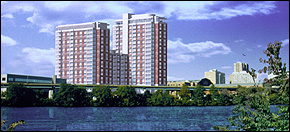![]()
Departments
![]()

|
28 August 1998 |
Vol. II, No. 4 |
Feature
Article
New 817-bed student residence is scheduled to open in fall of 2000
by Brian Fitzgerald
Boston University's newest construction project, an 18-story, 817-bed student residence that is scheduled to open in the fall of 2000 on the site of the former Commonwealth Armory, will be the largest housing facility built at BU in three decades. The $70 million building will help fulfill a longtime goal of the University: to have 75 percent of its undergraduates living on campus.
|
|
|
The new student residence on
the northeast portion of the Armory site will have
18-, 15-, and 9-story towers. The project is
scheduled to open in September 2000.
|
But most important, say University officials, the project will provide much-needed on-campus residences. "New student housing has been among our highest priorities this decade," says Peter Cusato, vice president of business affairs.
The building, to be located at 19 Buick St., will also help ease the area's housing crunch, according to BU's project notification form, submitted last March to the Boston Redevelopment Authority (BRA), the planning agency that reviews the city's development proposals. "By shifting undergraduates out of local rental housing and onto the campus, this project will benefit both the University community and the neighborhoods surrounding the University," says the document.
For years some neighborhood groups have raised concerns about students living off campus in nearby houses and apartments, arguing that their presence has a negative effect on the longtime residents' quality of life, and that the competition for housing puts too much pressure on a tight rental market.
Last April the Project Advisory Committee, composed of Boston and Brookline community members, along with University and city officials, approved the project -- as did the executive board of the BRA soon thereafter. Construction at the 10.2-acre site began in May.
The project was first proposed in the 1980s, but the real estate bust and economic downturn in the latter part of that decade made off-campus housing more affordable, as property values declined and nearby vacancy rates soared. After the stock market crash of 1987, when area rents plummeted, many students moved to apartments in Allston-Brighton. After some 1,200 students moved off campus, plans for a new student residence were put on hold.
But in the 1990s, on-campus housing has been in high demand, says Director of Housing Marc Robillard. "Students want housing that is safe, clean, and conveniently located," he points out. "They want quick response to maintenance problems, and they don't always get that with landlords off campus." So many students wanted to live on campus that a shortage in BU housing occurred. For the past few years, the University has housed students in Howard Johnson's hotels in Kenmore Square and Cambridge and has rented a dormitory in South Campus from Emmanuel College.
According to Boston University's 1986 Master Plan, a 10-year outline for development on the Charles River Campus, in light of the demographic trend of declining numbers of graduating high school seniors, the University's goal was to maintain a level of approximately 13,400 undergraduates, and house three-quarters of them on campus by 1993. But the 1996 Master Plan explains that enrollment figures exceeded that amount "because of effective recruitment methods both within and outside the primary recruitment area, including foreign countries." The most likely projection for 2000, says the updated Master Plan, is 3,500 entering freshmen and a total undergraduate enrollment of 13,708. During this period, the number of high school graduates nationally will increase, "but the University intends to stabilize enrollment and continue its practice of raising admission standards for incoming freshmen."
Now, with a strong economy, neighborhood rents at an all-time high, and funding for the construction of the new student residence in place (partially through the University's sale of bonds last year), Boston University is poised to alleviate its housing shortage. At present, 70 percent of BU's undergraduates live on campus. The 1996 Master Plan predicts that 75 percent of the University's undergraduates will live on campus by 2000.
Robillard says that in order to keep students on campus, BU had to provide more desirable housing options, especially for juniors and seniors. "When we first started planning this project, we looked at our entire housing inventory," he says. "We knew that we had a great residence system for freshmen and sophomores. But we did not have enough of the type of accommodations that juniors and seniors were looking for. We did extensive research and found that they want an apartment-style setting with single bedrooms. They didn't want to be in an apartment by themselves, but they desire some privacy. And they prefer to be fairly close to the core of the campus. The Armory site is ideal for that." BU obtained the property in 1983.
To encourage their undergraduates to stay on campus all four years, other colleges are building apartment-style accommodations, says Robillard. "Many of the students are coming from households in which they don't have a lot of brothers and sisters," he says, "and they typically have had their own bedrooms."
Most of the new student residence's apartments will consist of four single bedrooms, a kitchen, a living/dining area, and two full bathrooms. There will also be some two-bedroom units. The building will include apartments for residence hall staff, and possibly, faculty-in-residence. Each bedroom will have a link to the campus computer network and a phone connection, and the building will be air-conditioned. The residence will have a ground floor computer room, fitness room, games area, laundry facility, and common spaces for individual and group study. The 18th floor will have a multipurpose room with a bird's-eye view of the Charles River. The building's windows will be made of triple-paned glass to eliminate noise from the Massachusetts Turnpike. The residence will include two outside courtyards.
The architect for the new student residence is Cannon. The construction manager is Walsh Brothers, Inc.
